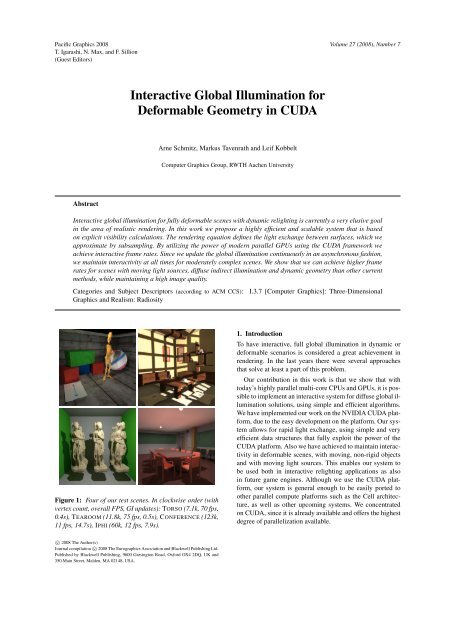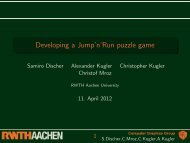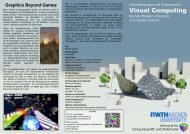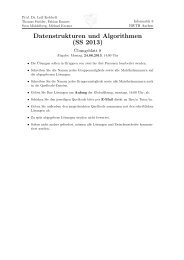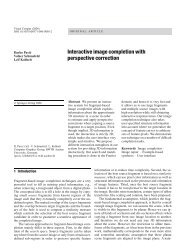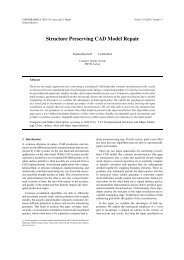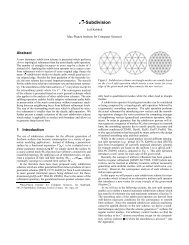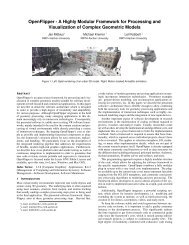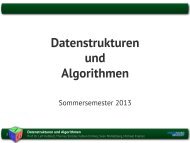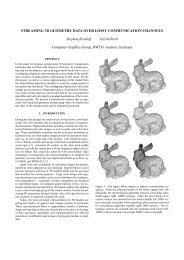Paper - Computer Graphics and Multimedia - RWTH Aachen ...
Paper - Computer Graphics and Multimedia - RWTH Aachen ...
Paper - Computer Graphics and Multimedia - RWTH Aachen ...
You also want an ePaper? Increase the reach of your titles
YUMPU automatically turns print PDFs into web optimized ePapers that Google loves.
Pacific <strong>Graphics</strong> 2008<br />
T. Igarashi, N. Max, <strong>and</strong> F. Sillion<br />
(Guest Editors)<br />
Volume 27 (2008), Number 7<br />
Interactive Global Illumination for<br />
Deformable Geometry in CUDA<br />
Arne Schmitz, Markus Tavenrath <strong>and</strong> Leif Kobbelt<br />
<strong>Computer</strong> <strong>Graphics</strong> Group, <strong>RWTH</strong> <strong>Aachen</strong> University<br />
Abstract<br />
Interactive global illumination for fully deformable scenes with dynamic relighting is currently a very elusive goal<br />
in the area of realistic rendering. In this work we propose a highly efficient <strong>and</strong> scalable system that is based<br />
on explicit visibility calculations. The rendering equation defines the light exchange between surfaces, which we<br />
approximate by subsampling. By utilizing the power of modern parallel GPUs using the CUDA framework we<br />
achieve interactive frame rates. Since we update the global illumination continuously in an asynchronous fashion,<br />
we maintain interactivity at all times for moderately complex scenes. We show that we can achieve higher frame<br />
rates for scenes with moving light sources, diffuse indirect illumination <strong>and</strong> dynamic geometry than other current<br />
methods, while maintaining a high image quality.<br />
Categories <strong>and</strong> Subject Descriptors (according to ACM CCS):<br />
<strong>Graphics</strong> <strong>and</strong> Realism: Radiosity<br />
I.3.7 [<strong>Computer</strong> <strong>Graphics</strong>]: Three-Dimensional<br />
Figure 1: Four of our test scenes. In clockwise order (with<br />
vertex count, overall FPS, GI updates): TORSO (7.1k, 70 fps,<br />
0.4s), TEAROOM (11.8k, 75 fps, 0.5s), CONFERENCE (123k,<br />
11 fps, 14.7s), IPHI (60k, 12 fps, 7.9s).<br />
1. Introduction<br />
To have interactive, full global illumination in dynamic or<br />
deformable scenarios is considered a great achievement in<br />
rendering. In the last years there were several approaches<br />
that solve at least a part of this problem.<br />
Our contribution in this work is that we show that with<br />
today’s highly parallel multi-core CPUs <strong>and</strong> GPUs, it is possible<br />
to implement an interactive system for diffuse global illumination<br />
solutions, using simple <strong>and</strong> efficient algorithms.<br />
We have implemented our work on the NVIDIA CUDA platform,<br />
due to the easy development on the platform. Our system<br />
allows for rapid light exchange, using simple <strong>and</strong> very<br />
efficient data structures that fully exploit the power of the<br />
CUDA platform. Also we have achieved to maintain interactivity<br />
in deformable scenes, with moving, non-rigid objects<br />
<strong>and</strong> with moving light sources. This enables our system to<br />
be used both in interactive relighting applications as also<br />
in future game engines. Although we use the CUDA platform,<br />
our system is general enough to be easily ported to<br />
other parallel compute platforms such as the Cell architecture,<br />
as well as other upcoming systems. We concentrated<br />
on CUDA, since it is already available <strong>and</strong> offers the highest<br />
degree of parallelization available.<br />
c○ 2008 The Author(s)<br />
Journal compilation c○ 2008 The Eurographics Association <strong>and</strong> Blackwell Publishing Ltd.<br />
Published by Blackwell Publishing, 9600 Garsington Road, Oxford OX4 2DQ, UK <strong>and</strong><br />
350 Main Street, Malden, MA 02148, USA.
Arne Schmitz, Markus Tavenrath & Leif Kobbelt / Interactive Global Illumination for Deformable Geometry in CUDA<br />
!∗ !+ !,<br />
<br />
<br />
<br />
<br />
!<br />
#∃∀%<br />
&∋<br />
∀%<br />
<br />
<br />
<br />
<br />
<br />
#∃<br />
(<br />
∀<br />
(<br />
<br />
∀<br />
<br />
<br />
<br />
<br />
<br />
Figure 1: The system is split into three parts: H<strong>and</strong>ling of<br />
dynamic objects, h<strong>and</strong>ling of dynamic light sources, <strong>and</strong> rendering.<br />
Dynamic objects <strong>and</strong> light sources are h<strong>and</strong>led asynchronously,<br />
to allow for high rendering performance.<br />
Our algorithm is based on explicit visibility computation.<br />
For typical medium-scale scenes we can achieve a rendering<br />
performance that is up to 2× higher than other current<br />
methods using implicit visibility. Also we can render more<br />
complex scenes than those methods. We also show that the<br />
performance scales with the number of GPUs in the computer<br />
system. If the compute power of the GPUs is doubled,<br />
the turnaround time for a full global illumination solution<br />
is approximately halved. For interactive lighting with static<br />
geometry we are about one order of magnitude faster than a<br />
comparable solution using implicit visibility.<br />
1.1. Related Work<br />
There are numerous works published in the field of Global<br />
Illumination. We will concentrate here on related work that<br />
is dealing with the real time aspect of it, <strong>and</strong> also on work<br />
that supports dynamic geometry.<br />
When looking at real time ray-tracing, one can find vast<br />
amounts of works that perform Whitted-style ray-tracing <strong>and</strong><br />
ray-casting. Notable here are the works of Popov, Shevtsov,<br />
<strong>and</strong> Horn [PGSS07,SSK07,HSHH07] where the main focus<br />
is on efficient kd-tree building <strong>and</strong> traversal. Furthermore<br />
Wald [WH] showed how to build kd-trees efficiently. In a<br />
similar work, Wächter et al. [WK06] showed how to use a<br />
variation of the kd-tree to make building <strong>and</strong> traversal more<br />
efficient. However, all those works <strong>and</strong> related ones only do<br />
simple ray-tracing without diffuse inter-reflections.<br />
Quite recently Dachsbacher et al. [DSDD07] presented an<br />
approach that computes an approximate solution by transmitting<br />
negative radiance through discrete bins of finite size.<br />
The underlying assumption is that radiance is invariant along<br />
rays, which is not the case for finite bins, so that some bias is<br />
introduced. Similar to that is Dong et al. [DKTS07], where<br />
a hierarchy is constructed that determines visibility implicitly.<br />
Both approaches allow diffuse reflections <strong>and</strong> indirect<br />
light bounces <strong>and</strong> can h<strong>and</strong>le dynamic scenes. Scenes with<br />
()<br />
dynamic elements have also been covered in other works, for<br />
example Wald et al. [WBS07] use bounding volume hierarchies,<br />
since they can be updated quite fast.<br />
An approach similar to ours is Havran et al. [HBHS05],<br />
in which they store photon paths <strong>and</strong> evaluate them when<br />
needed. We extend this by storing not only paths but a generalized<br />
link structure, that is evaluated similar to traditional<br />
radiosity methods, but instead we propagate radiance. Other<br />
methods also use a discrete ray sampling of the hemisphere<br />
on a surface point to evaluate the radiance [CPC84, WRC].<br />
There exist modernized versions of those algorithms, like the<br />
work by Gautron et al. [GKBP05], which map onto current<br />
GPU hardware. An approach by Heidrich et al. [HDKS00]<br />
uses precomputed visibility, which is related to our approach.<br />
Their work only h<strong>and</strong>les local visibility of static geometry,<br />
but allows for indirect illumination.<br />
Kristensen et al. developed a competing approach<br />
for interactive lighting [KAMJ05], which requires precomputations<br />
on a computer cluster but renders very fast.<br />
Another interactive lighting approach is by Yue et al.<br />
[YIDN07], which also requires pre-computations. Other<br />
methods related to this are PRT-based methods which use<br />
spherical harmonics or wavelets to store radiance [KTHS06,<br />
SLS05]. However dynamic scenes cannot be h<strong>and</strong>led in an<br />
easy way <strong>and</strong> the pre-computations take some time.<br />
2. System Overview<br />
For interactive global illumination systems, it is important<br />
to identify the main bottlenecks which are most time consuming.<br />
With global illumination using explicit visibility we<br />
have several compute-intensive parts.<br />
First, we have to build a spatial search structure. In our<br />
case this is a kd-tree, for accelerating the visibility tests.<br />
Building a kd-tree is computationally expensive, the lower<br />
bound being Ω(nlogn). Similar costs occur for determining<br />
the visibility in the scene. This is done by shooting rays,<br />
each of which has O(logn) complexity. If mutual visibility<br />
of all elements is to be computed, O(n 2 logn) time is needed.<br />
Since this is prohibitive for large scenes, we use an undersampling<br />
to reduce the complexity. This results in a linkstructure<br />
which determines the possible paths the light can<br />
take in the scene.<br />
The second most expensive step in the rendering pipeline<br />
is computing the light exchange. Light is propagated through<br />
the scene by gathering on the link-structure. Also, for interactive<br />
light design we support static geometry <strong>and</strong> moving<br />
light sources. This allows us to update only the links from the<br />
light source to the static scene geometry. Furthermore, GPUs<br />
can efficiently compute the direct illumination, which can be<br />
used to lessen the workload on other parts of the pipeline.<br />
The rendering is the last step, <strong>and</strong>, although it is also computationally<br />
expensive, can be done efficiently on consumer<br />
graphics hardware. So this is not a great concern for implementing<br />
an efficient global illumination pipeline.<br />
c○ 2008 The Author(s)<br />
Journal compilation c○ 2008 The Eurographics Association <strong>and</strong> Blackwell Publishing Ltd.
Arne Schmitz, Markus Tavenrath & Leif Kobbelt / Interactive Global Illumination for Deformable Geometry in CUDA<br />
Our proposed system uses this information to provide<br />
three distinct algorithmic parts to maintain a guaranteed<br />
frame rate. This allows for maximum flexibility in the user’s<br />
interaction with the system. Figure 1 shows the structure<br />
of our proposed rendering pipeline. It achieves interactive,<br />
guaranteed frame rates by splitting the workload into three<br />
parts for deformable geometry, interactive relighting, <strong>and</strong><br />
rendering of the scene using OpenGL.<br />
The stages presented in Figure 1 run partially on the CPU<br />
<strong>and</strong> partially on the GPU. The first stage for dynamic geometry,<br />
including kd-tree compilation <strong>and</strong> link compression<br />
runs on the CPU, while the visibility tests run on the GPU. In<br />
the second stage, light link sampling <strong>and</strong> the light exchange<br />
run on the GPU. The light exchange only uses one GPU at<br />
the moment, since it is the fastest part of the algorithm <strong>and</strong><br />
synchronization of multiple GPUs is less efficient. The third<br />
stage consists of rendering the direct light on the GPU. We<br />
manage to get both the CPU <strong>and</strong> the GPUs to be utilized<br />
evenly, with the main parts being the kd-tree compilation on<br />
the CPU <strong>and</strong> the visibility computation on the GPU.<br />
2.1. Architecture<br />
Our work uses the NVIDIA CUDA computing platform<br />
[NVI07] for link generation <strong>and</strong> light exchange, while rendering<br />
is performed using OpenGL. The system is generalized<br />
in such a way that it is easily portable to other compute<br />
platforms. The CUDA system allows for a much simpler<br />
development process, compared to traditional shading<br />
languages like GLSL or HLSL, since the code is mostly st<strong>and</strong>ard<br />
C <strong>and</strong> allows easy debugging.<br />
Most parts of the algorithm run asynchronously to allow<br />
for interactive frame rates. Updates to the scene’s illumination<br />
are computed in the background. In section 4.1 we will<br />
discuss the scalability of our approach. This is an important<br />
aspect of our system, since we can easily take advantage of<br />
more computing power, in the form of more CPU cores or<br />
GPUs. With the current trend of more cores on the chip our<br />
system will scale well with future hardware generations.<br />
2.2. Explicit Visibility<br />
We chose to use explicit visibility, in contrast to some recent<br />
approaches. The alternative to use implicit visibility as described<br />
in Dachsbacher et al. [DSDD07] would allow us to<br />
omit the kd-tree <strong>and</strong> the expensive ray-queries. However the<br />
convergence of these algorithms depend on the depth complexity<br />
of the scene. That is as many iterations are needed<br />
to converge to a correct solution as there are layers of occluding<br />
objects. Also the link structure of implicit visibility<br />
algorithms can consume quite a lot of memory.<br />
3. Algorithm<br />
This section explains the different stages of our algorithm.<br />
The main steps being kd-tree construction, link generation,<br />
initial radiance updates <strong>and</strong> rendering.<br />
Rays (1000/s)<br />
6000<br />
5500<br />
5000<br />
4500<br />
4000<br />
3500<br />
3000<br />
2500<br />
2000<br />
1500<br />
1000<br />
500<br />
16<br />
64<br />
144<br />
256<br />
400<br />
Rays in batch<br />
579<br />
Tearoom<br />
Iphi<br />
Torso<br />
784<br />
1024<br />
Figure 2: This graph shows how the number of rays shot<br />
at each vertex influences the number of rays shot per second<br />
for different scenes. The more rays are shot per vertex, the<br />
more coherent those rays are, <strong>and</strong> the higher the throughput.<br />
3.1. kd-Tree Construction<br />
For dynamic scenes, a fast construction of the kd-tree is important.<br />
At the same time the ray-traversal during link construction<br />
needs to be fast. Because of this, we use the surface<br />
area heuristic (SAH) during tree construction [MB90]. Since<br />
the SAH is costly, we utilize initial clustering in the same<br />
way as Shevtsov et al. [SSK07]. In the first log 2 N C levels of<br />
the kd-tree we use an object median split along the longest<br />
axis of the current node’s bounding box, where N C denotes<br />
the number of processing cores of the host CPU. After these<br />
first levels, we have N C leaf nodes. After that we do parallel<br />
subtree construction using the SAH heuristic. It should be<br />
noted that quite recently Zhuo et al. [ZHWG08] presented<br />
a method to build the kd-tree efficiently on the GPU, which<br />
could probably make our system even faster.<br />
After the tree has been constructed, we use the optimization<br />
algorithm of Popov et al. [PGSS07], to generate ropes<br />
at the leafs of the tree, to accelerate traversal.<br />
3.2. Ray Shooting <strong>and</strong> Link Generation<br />
Using the kd-tree created in this way we achieve between<br />
0.5 <strong>and</strong> 5 million ray-traversals per second for highly incoherent<br />
secondary rays. The worst case happens in badly tesselated<br />
scenes with triangles of greatly varying size, while<br />
uniformly tesselated shapes tend to produce better trees.<br />
The basis of our algorithm is the surface parameterization<br />
of the rendering equation [DBB06]:<br />
Z<br />
L(x ← Θ) =L e(x ← Θ)+ f r(y,ψ ↔ −→ yz)<br />
A<br />
L(y ← −→ (1)<br />
yz)V(y,z)G(y,z)dA z<br />
With y = r(x,Θ) <strong>and</strong> V being the visibility term <strong>and</strong> G the<br />
geometry term. The goal of the ray shooting step is to create<br />
a radiance link structure. Every link is defined between vertices<br />
<strong>and</strong> weighted with the visibility <strong>and</strong> the geometry term<br />
c○ 2008 The Author(s)<br />
Journal compilation c○ 2008 The Eurographics Association <strong>and</strong> Blackwell Publishing Ltd.
Arne Schmitz, Markus Tavenrath & Leif Kobbelt / Interactive Global Illumination for Deformable Geometry in CUDA<br />
<br />
<br />
<br />
<br />
<br />
∀<br />
#∃<br />
#∃∋<br />
&<br />
<br />
<br />
<br />
! <br />
∋(<br />
%<br />
<br />
<br />
<br />
<br />
<br />
<br />
<br />
<br />
<br />
<br />
<br />
! <br />
! <br />
<br />
#∃<br />
!<br />
∋(<br />
∋(<br />
<br />
%<br />
%<br />
<br />
Figure 3: This figure depicts the ray generation pipeline. Elements consisting of a vertex <strong>and</strong> a normal form the input. We<br />
provide a discrete set of directions that are to be sampled (left). After the ray intersection from each vertex with each direction,<br />
we get an array of element hits (middle) that is transformed into the final link structure (right). Every element now has a link<br />
group of variable length associated, which points into the large link array.<br />
respectively. By repeatedly gathering radiance on the link<br />
structure, we achieve the evaluation of equation (1) by iteration.<br />
The initial values are computed by explicit lighting,<br />
as described in section 3.3 <strong>and</strong> the gathering is described in<br />
section 3.3. After gathering, the radiance values are interpolated<br />
by the OpenGL shader during the rendering step.<br />
There are two ways to shoot the rays. One is to traverse<br />
them synchronously, in step with the rendering pipeline.<br />
This leads to lower frame rates, since the ray shooting is very<br />
expensive. Therefore we perform asynchronous ray shooting,<br />
which results in an interactive rendering of the scene,<br />
while a full global illumination solution is computed at a<br />
lower frame rate <strong>and</strong> h<strong>and</strong>ed to the OpenGL renderer when<br />
finished.<br />
Ray Generation The ray shooting is divided into batches<br />
that are sent to all available CUDA devices. The CPU is<br />
used for creating these batches <strong>and</strong> later evaluating them <strong>and</strong><br />
for computing the final vertex colors. Every batch consists<br />
of a number of elements (i.e. vertices), their local coordinate<br />
basis, described by their normal vector, <strong>and</strong> a set C Ω of<br />
ray directions to be sampled. In most examples we choose<br />
n C = 256 distinct ray directions, covering the hemisphere in<br />
a cosine-weighted fashion. The directions have to be transferred<br />
only once, since they are transformed into the local<br />
basis of every element when needed.<br />
Every processed batch returns an array of n C hit-structures<br />
that contain the element id that was hit, <strong>and</strong> the barycentric<br />
coordinates of the hit, as also the distance t on the ray. From<br />
these hit structures, we generate the final link structure. Every<br />
element is associated with a variably sized link group,<br />
that points into the link array. See Figure 3 for a detailed<br />
visualization of the data structures used.<br />
We are computing radiance on vertices by building vertexto-vertex-links.<br />
But in the shooting stage we intersect with<br />
triangles. We need to distribute the information from the<br />
shooting stage to the vertices of the mesh. Consider that we<br />
have hit the point x = uA+vB+wC on a triangle. We generate<br />
three links, weighted with their barycentric coordinates.<br />
This weighting is necessary to satisfy the energy balance,<br />
since we sample only n C directions on the hemisphere.<br />
The hits found in this process are used to build the link<br />
structure. However this produces a large number of redundant<br />
links, since many rays hit the same triangle <strong>and</strong> therefore<br />
links to certain vertices are very redundant. Hence we<br />
combine sets of links where both source <strong>and</strong> destination<br />
vertex are the same, which results in compression ratios of<br />
about 3 to 5 times. This is done by a straightforward algorithm<br />
on the CPU after the shooting stage. First we iterate<br />
over all links of a vertex <strong>and</strong> accumulate the geometry terms<br />
G for specific peer vertices in an array. In a second iteration<br />
we loop over all vertices found in the first iteration <strong>and</strong><br />
generate new links with the accumulated weighted geometry<br />
terms.<br />
A great advantage of our system is, that the total number<br />
of links scales at most linearly with the number of elements<br />
used, since every element only has a constant number<br />
of links. The link compression is computationally rather inexpensive,<br />
so that it pays off in the light exchange step <strong>and</strong><br />
allows for high update rates for moving light sources.<br />
There are some notable observations when implementing<br />
this on current CUDA hardware. First of all memory access<br />
is very expensive on recent graphics devices, since GPUs<br />
have only very small caches for the individual threads in<br />
the multiprocessor. Also just read-only memory is cached.<br />
For example the G80 series of GPUs provides 8192 bytes of<br />
cache for textures, which is very small. Since we store our<br />
tree in texture memory, the rays that traverse the tree should<br />
be as coherent as possible, to maximize the cache hit rate.<br />
One limitation of the CUDA architecture is that the dimensions<br />
of a texture are limited. Therefore we store our linear<br />
data structures in 2D textures.<br />
For maximizing the coherent number of rays, we use a<br />
concentric map that projects samples from a square to a disc.<br />
See Shirley et al. [SC97] for details on this map. We sample<br />
the square in blocks of size 4×4, use the map to get samples<br />
on a disc <strong>and</strong> then project the samples onto the hemisphere<br />
above the element. Also note that for maximum efficiency<br />
you should take two such 4 × 4 blocks, resulting in 32 relatively<br />
coherent rays. This maps best to the CUDA architecture<br />
where 32 threads are always running in lock-step in a so<br />
c○ 2008 The Author(s)<br />
Journal compilation c○ 2008 The Eurographics Association <strong>and</strong> Blackwell Publishing Ltd.
Arne Schmitz, Markus Tavenrath & Leif Kobbelt / Interactive Global Illumination for Deformable Geometry in CUDA<br />
called warp. In every warp, threads have to follow the same<br />
code-path. Diverging code paths have an impact on runtime.<br />
Another implication of this architecture is that the more<br />
rays are shot in the hemisphere, the higher the raythroughput<br />
gets. This is because the 4 × 4 ray blocks get<br />
more local <strong>and</strong> more coherent. That is also why packetizing<br />
the rays in a classic sense does not scale well on GPUs.<br />
Coherence of the four border rays of a packet will always<br />
be lower than when traversing all the rays explicitly. Also<br />
splitting packets is very expensive on GPUs, because of the<br />
lock-stepping of the warps. We noticed that on the G80 architecture,<br />
shooting 16×16 rays per vertex with 4×4 blocks<br />
was a good compromise between total run-time, number of<br />
rays shot per second <strong>and</strong> total number of links generated.<br />
Figure 2 shows this dependency of throughput to number of<br />
rays per vertex.<br />
Scheduling <strong>and</strong> Balancing Building the kd-tree <strong>and</strong> link<br />
generation is run asynchronously. Depending on the scene<br />
complexity we achieve one to five complete global illumination<br />
updates per second, for medium complex scenes. Highly<br />
complex scenes, like the CONFERENCE scene with more<br />
than 100k elements, can be h<strong>and</strong>led with updates to the lighting<br />
situation around every 0.4 seconds, <strong>and</strong> full updates including<br />
dynamic geometry every 12 seconds.<br />
To allow for better performance, we use a load balancing<br />
on the CUDA devices. In a system with two or more CUDA<br />
devices, the individual ray batches take different amount of<br />
time for traversal. Our load balancing scheduler distributes<br />
the ray-batches in such a way, that all installed CUDA devices<br />
take the same time to process the batches, based on<br />
their performance in the last batch.<br />
3.3. Updating the Light Source<br />
Although the latency for a complete global illumination update<br />
for the whole scene is already quite low in our system,<br />
we achieve very high frame rates for moving light sources.<br />
Similar to Kristensen et al. [KAMJ05] we can interactively<br />
move light sources, but instead of hours to weeks of precomputation<br />
we can h<strong>and</strong>le many scenes in fractions of a<br />
second, if the geometry of the scene changes. Implicit visibility<br />
methods like Dachsbacher et al. [DSDD07] also allow<br />
for interactive light source manipulation, but we still have<br />
a faster turnaround time, if the whole scene changes, plus<br />
we achieve higher frame rates when only the light source is<br />
moving, see Section 5 for more information.<br />
Lightlink Sampling We support up to eight fully dynamic<br />
directional or point light sources, which use cube shadow<br />
maps with adaptive percentage closer filtering for smooth<br />
edges. Also the light sources support full high dynamic<br />
range RGB color, for enhanced flexibility during lighting<br />
design. Using multi-pass rendering it would be possible to<br />
support arbitrary numbers of light-sources, albeit with loss<br />
of performance. Area lights are also easy to implement in<br />
Figure 4: We compute the direct lighting via a simple<br />
OpenGL shader (left), the indirect lighting via our light exchange<br />
(middle), <strong>and</strong> the combined image is a sum of the two<br />
first images, computed in the shader (right).<br />
our system, one just has to change the ray origins of the light<br />
samples to cover the surface of the light source.<br />
Whenever a light source is moved, we establish explicit<br />
visibility of the light source with all elements in the scene.<br />
This is done by shooting rays from the light source to the<br />
element. This allows us to compute the geometry <strong>and</strong> visibility<br />
term between both, <strong>and</strong> we then initialize the radiance<br />
at each vertex. The geometry term is defined as:<br />
G(x,y) =<br />
cosθx cosθy<br />
r 2 xy<br />
Since we only sample the vertices of the mesh, we are<br />
prone to aliasing <strong>and</strong> undersampling, especially in respect to<br />
the light sources. Therefore we do an oversampling of the<br />
visibility term, by also shooting rays from the lightsource to<br />
selected points on the triangles in the one-ring around the<br />
target vertex. We use a 1:4 subdivision scheme to determine<br />
the additional sampling points.<br />
After determining the geometry term from each light<br />
source to all elements in the scene, we initialize the elements’<br />
outgoing radiance with the light they received from<br />
the light sources, multiplied by their BRDF.<br />
Radiance Propagation by Gathering After each element<br />
has received its initial outgoing radiance, we start to propagate<br />
the radiance through the scene by means of gathering.<br />
We just iterate over all elements, <strong>and</strong> collect the radiance<br />
from all its links. The radiance is summed to the total incoming<br />
radiance, weighted by the geometry <strong>and</strong> visibility<br />
term:<br />
(2)<br />
I total,x,i+1 = I total,x,i +∑<br />
y<br />
I outgoing,y ·V(x,y)G(x,y) (3)<br />
The new outgoing radiance of an element is simply the incoming<br />
radiance from all incoming links x ← y multiplied<br />
by the diffuse reflectance f d :<br />
∑<br />
I outgoing,x = I outgoing,y · f d (4)<br />
{y|x←y}<br />
One such summing over all elements results in one light<br />
propagation bounce. In most scenes, four iterations result in<br />
a sufficient light distribution. Thus the radiance gathering<br />
itself is one of the cheapest parts of our algorithm.<br />
Since we use a subsampling of the path space, we are<br />
c○ 2008 The Author(s)<br />
Journal compilation c○ 2008 The Eurographics Association <strong>and</strong> Blackwell Publishing Ltd.
Arne Schmitz, Markus Tavenrath & Leif Kobbelt / Interactive Global Illumination for Deformable Geometry in CUDA<br />
Figure 5: Left: our method, Middle: Luxrender unbiased<br />
renderer. Right: absolute difference of radiance values. Differences<br />
are at shadow boundaries. Also under the tea bowl<br />
some light paths were missed by our algorithm.<br />
prone to the same noise artifacts as similar algorithms, like<br />
distributed ray-tracing by Cook et al. [CPC84]. However, in<br />
our case we can easily perform a radiance smoothing step on<br />
the vertices:<br />
( )<br />
1<br />
I smooth,v =<br />
I v +<br />
|N(v)|+1<br />
∑ I vi (5)<br />
v i∈N(v)<br />
Where N(v) is the one-ring of vertex v. This eliminates practically<br />
all noise that stems from the path space subsampling.<br />
One has to be careful not to smooth over feature edges, since<br />
there the radiance will probably be non-continuous. So instead<br />
of smoothing over N(v), we smooth over ˆN(v), which<br />
is defined as:<br />
ˆN(v) = { v i |v i ∈ N(v) ∧ n v · n vi > cosα f<br />
}<br />
(6)<br />
Where α f is a threshold angle for feature edges, which can<br />
be user defined per mesh or per scene. These feature edges<br />
are also used for the direct lighting, to produce sharp edges<br />
on meshes. Note that our work is dependent on the tesselation<br />
of the scene, since higher tesselation will allow for a<br />
more accurate resolution of the indirect lighting.<br />
3.4. Rendering<br />
We download the computed total incoming radiance values<br />
from CUDA, <strong>and</strong> use it as input for our vertex buffer based<br />
mesh rendering. Since our elements coincide with the rendered<br />
vertices, this is a one to one mapping.<br />
The surface shading is based on a simple split of the rendering<br />
equation into the direct <strong>and</strong> indirect illumination. The<br />
direct illumination is evaluated by a simple diffuse or glossy<br />
BRDF combined with cube mapped shadow maps for each<br />
light source. The shadow maps are rendered with percentage<br />
closer filtering, which smoothes out any aliasing artifacts.<br />
The indirect radiance is then added to that. Figure 4 shows<br />
how the two parts of the rendering equation are put together.<br />
4. Discussion<br />
The two most important aspects to discuss about a global<br />
illumination system are performance <strong>and</strong> image quality. In<br />
respect to performance, the scalability of is very important.<br />
Specific timings will be discussed in Section 5, while in this<br />
section we will discuss computational complexity.<br />
Figure 6: Our system is even able to h<strong>and</strong>le large models.<br />
Shown are direct <strong>and</strong> indirect light (one <strong>and</strong> four bounces).<br />
4.1. Scalability<br />
One of the big problems of global illumination is, that when<br />
one uses finite element methods, that the problem is equivalent<br />
to the n-body problem, as shown by Hanrahan et al.<br />
[HSA91]. This implies that naive solutions will always take<br />
O(n 2 ) to complete, where in the following n will denote<br />
the number of elements in the scene (in our case vertices).<br />
This can be solved for small scenes on current hardware, but<br />
obviously this does not scale well. Using hierarchical approaches,<br />
this can be pushed down to O(nlogn) in both time<br />
an space complexity.<br />
Time <strong>and</strong> Space Complexity Our approach has linear<br />
space complexity, linear time complexity for light exchange<br />
<strong>and</strong> a log-linear time complexity for visibility <strong>and</strong> link construction.<br />
So for dynamic scenes we need to consider the following<br />
costs. First we need to build the kd-tree, which can be<br />
accomplished in t kd = O(nlogn) time. The shooting step for<br />
generating the links between elements takes t shoot = O(n C ·<br />
nlogn), where n C is the number of sampled directions. Computing<br />
the light links takes t light = O(n L ·nlogn) time, where<br />
n L is the number of light sources in the scene. The light exchange<br />
itself is performed in t radiance = O(n B · n C · n) time,<br />
where n B is the number of bounces. This is the greatest advantage<br />
of our approach compared to other works, since our<br />
method scales linearly with the number of elements in the<br />
scene. Other methods, as shown in the next paragraph, usually<br />
take at least log-linear time. We can now see that computing<br />
the whole global illumination solution from scratch<br />
takes<br />
t f ull = t kd +t shoot +t light +t radiance (7)<br />
= O((1+n C + n L )nlogn+n B · n C · n) (8)<br />
For medium sized scenes of a few ten-thous<strong>and</strong> triangles,<br />
we achieve still interactive rates for t f ull . And as discussed<br />
earlier, light updates are much cheaper:<br />
t f ulllight = t light +t radiance (9)<br />
= O(L · nlogn)+O(n B · n C · n) (10)<br />
Scalability Compared With Other Methods In comparison,<br />
the work by Dachsbacher et al. [DSDD07] is a bit more<br />
difficult to analyze. They also use a discrete set of directions,<br />
for which they produce links. Due to the implicit visibility,<br />
their link structure contains O(n 2 ) links in the worst case, because<br />
bins can contain more than one link. This is dealt with<br />
c○ 2008 The Author(s)<br />
Journal compilation c○ 2008 The Eurographics Association <strong>and</strong> Blackwell Publishing Ltd.
Arne Schmitz, Markus Tavenrath & Leif Kobbelt / Interactive Global Illumination for Deformable Geometry in CUDA<br />
by using a link hierarchy. The authors do not state an accurate<br />
value for the space complexity, but due to the hierarchy<br />
it might be Ω(nlogn). The complexity of constructing the<br />
link structure is completely unknown, but their initial linking<br />
phase takes 13s for the oriental scene, which is equivalent to<br />
our TEAROOM scene. Our algorithm takes t f ull = 1.1s, <strong>and</strong><br />
renders the scene with 65 frames per second, compared to<br />
7.5 fps in the work of Dachsbacher et al. [DSDD07]. In both<br />
cases full indirect lighting is update in each frame. Their net<br />
number of links in this scene is 776k, while ours is 2019k.<br />
But still our light exchange is computed much faster. We<br />
need 6ms in total, while their algorithm takes 111ms. The<br />
tests were performed on similar machines, albeit our CPU<br />
ran at 2.4GHz, versus 3.0GHz. In both cases the graphics<br />
cards used were GeForce 8800 GTX.<br />
A second work that produces similar results as our approach<br />
is [DKTS07]. They use implicit visibility, which is<br />
computed during construction of a link hierarchy. They support<br />
only diffuse indirect illumination <strong>and</strong> dynamic models.<br />
The complexity of their method is unclear. They state an approximate<br />
complexity of O(nlogn). When comparing both<br />
systems, we noticed, that our approach can compete with<br />
theirs. However they only cite timings for small scenes. For<br />
a 2670 vertex scene their approach achieves 7.53 fps. We<br />
achieve 6.3 GI updates per second on a scene with the same<br />
complexity. However it has to be noted, that their approach<br />
uses only one bounce of indirect illumination. More bounces<br />
are more costly than in our approach.<br />
4.2. Image Quality<br />
Since we are sampling radiance at vertices, the computed<br />
values are interpolated over the surface by the graphics card.<br />
A higher tesselation will result in a more accurate interpolation.<br />
Also, the more rays are used at each vertex, the better<br />
the radiance estimate will be.<br />
A very important aspect of our system is that it h<strong>and</strong>les<br />
indirect illumination very well. Since the light exchange is<br />
computed so rapidly, the computation of many light bounces<br />
is possible. In scenes like TEAROOM large parts of the scene<br />
are illuminated indirectly.<br />
For proof of a good convergence of our algorithm, we<br />
compared our method with an unbiased path tracer called<br />
Luxrender, which is based on the well known PBRT by Pharr<br />
et al [PH04]. As can be seen from figure 5 our method converges<br />
to a correct solution. The main differences are mostly<br />
the shadow boundaries, which is due to the usage of shadow<br />
maps, but also some difficult light paths may not be found by<br />
our algorithm. But the absolute difference in radiance values<br />
is marginal. The reference solution was computed in 24<br />
hours time with approximately 10,000 samples per pixel.<br />
5. Results<br />
We have mainly used five different scenes to test our system.<br />
The geometric complexity of the scenes, <strong>and</strong> the complexity<br />
Scene Vtx kd-nodes Links·10 6<br />
·10 3 ·10 3 MB raw cmp<br />
COLORLAMP 1.6 1037 0.4 3.6 0.5<br />
TORSO 7.1 17.5 1.7 3.4 0.8<br />
TEAROOM 11.9 14.2 1.5 6.7 2.0<br />
IPHI 76.5 109 9.4 42 12<br />
CONFERENCE 122.8 297 30 73 14<br />
Table 1: The scenes used for testing. The number of links is<br />
shown in raw, <strong>and</strong> compressed form.<br />
of the resulting kd-trees are listed in Table 1. All scenes were<br />
built from scratch, except for the import of the more complex<br />
meshes.<br />
A detailed performance comparison of the test scenes can<br />
be found in Table 2. There we used two systems to test if our<br />
system scales well with the number of GPUs in the system.<br />
As can be seen from the table, the number of rays shot <strong>and</strong><br />
the waiting time for the first frame (which equals t f ull , see<br />
section 4.1) directly reflects the number of GPUs installed.<br />
Ray throughput almost doubles, for the general link generation.<br />
Especially note that the TORSO scene is fully dynamic<br />
<strong>and</strong> achieves very high frame rates. We also ran our algorithm<br />
with an emulated 4 GPUs, which worked well. True<br />
benchmarks on a 4 GPU machine will be done in the future.<br />
Our results show that we render faster than competing<br />
methods <strong>and</strong> we can h<strong>and</strong>le models one magnitude larger<br />
than said methods (see Figure 6). Furthermore we showed<br />
that our system is scalable with future GPU <strong>and</strong> CPU generations.<br />
6. Conclusion<br />
We have shown that with the CUDA framework, fast <strong>and</strong><br />
scalable diffuse global illumination in deformable scenes<br />
can be computed. Our work improves the possible performance<br />
especially for interactive relighting of diffuse scenes.<br />
The next step will be to further reduce the number of links<br />
that are needed, for example by using a hierarchy. We are<br />
currently working on support for glossy indirect illumination,<br />
which will be implemented shortly.<br />
The current implementation renders only point lights, directed<br />
or omnidirectional, with filtered cube shadow maps.<br />
Area lights are possible <strong>and</strong> are intended as future work.<br />
Furthermore we want to evaluate how the temporal appearance<br />
of the asynchronous global illumination can be improved.<br />
For fast moving objects the indirect illumination information<br />
might be too much out of date <strong>and</strong> lead to unpleasant<br />
visual artifacts. This will be a focus of improvement.<br />
Last, we also want to see how well our approach works<br />
on other parallel systems, like the Cell platform. The much<br />
bigger local memory of the Cell will probably allow for more<br />
complex operations, although the Cell has much fewer cores<br />
than a typical CUDA device.<br />
c○ 2008 The Author(s)<br />
Journal compilation c○ 2008 The Eurographics Association <strong>and</strong> Blackwell Publishing Ltd.
Arne Schmitz, Markus Tavenrath & Leif Kobbelt / Interactive Global Illumination for Deformable Geometry in CUDA<br />
Scene Sys kd-Tree Gen. Links Light links Bounces First FPS<br />
ms ms 10 3 rays/s ms 10 3 rays/s ms frame<br />
COLORLAMP A 8 833 1930 4 393 3 0.8s 54.0<br />
B 9 433 3709 5 314 2 0.5s 42.3<br />
TORSO A 111 413 4420 15 476 4 0.5s 65.0<br />
B 78 256 7121 19 397 4 0.4s 70.0<br />
TEAROOM A 71 680 4472 13 915 6 0.8s 65.0<br />
B 53 400 7595 15 793 6 0.5s 75.0<br />
IPHI A 35 11382 1721 92 832 54 12.4s 12.5<br />
B 47 5422 3614 103 746 56 7.9s 12.6<br />
CONFERENCE A 173 21606 1454 472 260 57 25.2s 10.0<br />
B 218 11403 2755 516 207 61 14.7s 11.5<br />
Table 2: This table shows the performance of systems A) Core2Duo 2.4 GHz, GeForce 8800 Ultra, B) Core2Quad 2.4 GHz,<br />
Dual GeForce 8800 Ultra. The time for the first frame, which equals the time for a full global illumination update, is reduced<br />
significantly, because the ray throughput almost doubles. All scenes use 3 bounces of indirect light.<br />
Acknowledgements<br />
Thanks to Bassam Kurdali for the Manc<strong>and</strong>y model used in<br />
the TORSO scene.<br />
References<br />
[CPC84] COOK R. L., PORTER T., CARPENTER L.: Distributed<br />
ray tracing. SIGGRAPH Comput. Graph. 18, 3 (1984), 137–145.<br />
[DBB06] DUTRÉ P., BALA K., BEKAERT P.: Advanced Global<br />
Illumination, 2nd Edition. A K Peters Ltd., 2006.<br />
[DKTS07] DONG Z., KAUTZ J., THEOBALT C., SEIDEL H.-P.:<br />
Interactive global illumination using implicit visibility. In Pacific<br />
Conference on <strong>Computer</strong> <strong>Graphics</strong> <strong>and</strong> Applications (Washington,<br />
DC, USA, 2007), IEEE <strong>Computer</strong> Society.<br />
[DSDD07] DACHSBACHER C., STAMMINGER M., DRETTAKIS<br />
G., DURAND F.: Implicit Visibility <strong>and</strong> Antiradiance for Interactive<br />
Global Illumination. ACM Transactions on <strong>Graphics</strong> (SIG-<br />
GRAPH) 26, 3 (August 2007).<br />
[GKBP05] GAUTRON P., KŘIVÁNEK J., BOUATOUCH K., PAT-<br />
TANAIK S.: Radiance cache splatting: a GPU-friendly global<br />
illumination algorithm. In SIGGRAPH ’05 (2005), ACM, p. 36.<br />
[HBHS05] HAVRAN V., BITTNER J., HERZOG R., SEIDEL H.-<br />
P.: Ray maps for global illumination. In EGSR (2005).<br />
[HDKS00] HEIDRICH W., DAUBERT K., KAUTZ J., SEIDEL H.-<br />
P.: Illuminating micro geometry based on precomputed visibility.<br />
In SIGGRAPH ’00 (2000), ACM, pp. 455–464.<br />
[HSA91] HANRAHAN P., SALZMAN D., AUPPERLE L.: A rapid<br />
hierarchical radiosity algorithm. In SIGGRAPH ’91 (New York,<br />
NY, USA, 1991), ACM, pp. 197–206.<br />
[HSHH07] HORN D. R., SUGERMAN J., HOUSTON M., HAN-<br />
RAHAN P.: Interactive k-d tree GPU raytracing. In I3D ’07 (New<br />
York, NY, USA, 2007), ACM, pp. 167–174.<br />
[KAMJ05] KRISTENSEN A. W., AKENINE-MÖLLER T.,<br />
JENSEN H. W.: Precomputed local radiance transfer for<br />
real-time lighting design. ACM Trans. Graph. 24, 3 (2005).<br />
[KTHS06] KONTKANEN J., TURQUIN E., HOLZSCHUCH N.,<br />
SILLION F.: Wavelet radiance transport for interactive indirect<br />
lighting. In Rendering Techniques 2006 (EGSR) (jun 2006).<br />
[MB90] MACDONALD D. J., BOOTH K. S.: Heuristics for ray<br />
tracing using space subdivision. Vis. Comput. 6, 3 (1990).<br />
[NVI07] NVIDIA CORPORATION: NVIDIA CUDA Programming<br />
Guide, 2007.<br />
[PGSS07] POPOV S., GÜNTHER J., SEIDEL H.-P., SLUSALLEK<br />
P.: Stackless kd-tree traversal for high performance GPU ray<br />
tracing. <strong>Computer</strong> <strong>Graphics</strong> Forum 26, 3 (Sept. 2007).<br />
[PH04] PHARR M., HUMPHREYS G.: Physically Based Rendering:<br />
From Theory to Implementation. Morgan Kaufmann Publishers<br />
Inc., San Francisco, CA, USA, 2004.<br />
[SC97] SHIRLEY P., CHIU K.: A low distortion map between<br />
disk <strong>and</strong> square. journal of graphics tools 2, 3 (1997), 45–52.<br />
[SLS05] SLOAN P.-P., LUNA B., SNYDER J.: Local, deformable<br />
precomputed radiance transfer. ACM Trans. Graph. 24, 3 (2005).<br />
[SSK07] SHEVTSOV M., SOUPIKOV A., KAPUSTIN A.: Highly<br />
Parallel Fast KD-tree Construction for Interactive Ray Tracing of<br />
Dynamic Scenes. <strong>Computer</strong> <strong>Graphics</strong> Forum 26, 3 (Sep 2007).<br />
[WBS07] WALD I., BOULOS S., SHIRLEY P.: Ray Tracing Deformable<br />
Scenes using Dynamic Bounding Volume Hierarchies.<br />
ACM Transactions on <strong>Graphics</strong> 26, 1 (2007).<br />
[WH] WALD I., HAVRAN V.: On building fast kd-trees for ray<br />
tracing, <strong>and</strong> on doing that in O(N log N). In Interactive Ray<br />
Tracing 2006.<br />
[WK06] WÄCHTER C., KELLER A.: Instant Ray Tracing: The<br />
Bounding Interval Hierarchy. In Symposium on Rendering<br />
(2006), pp. 139–149.<br />
[WRC] WARD G. J., RUBINSTEIN F. M., CLEAR R. D.: A ray<br />
tracing solution for diffuse interreflection. In SIGGRAPH ’88,<br />
ACM.<br />
[YIDN07] YUE Y., IWASAKI K., DOBASHI Y., NISHITA T.:<br />
Global illumination for interactive lighting design using light<br />
path pre-computation <strong>and</strong> hierarchical histogram estimation. Pacific<br />
<strong>Graphics</strong> (2007), 87–98.<br />
[ZHWG08] ZHOU K., HOU Q., WANG R., GUO B.: Real-Time<br />
KD-tree Construction on <strong>Graphics</strong> Hardware. Technical Report<br />
(2008).<br />
c○ 2008 The Author(s)<br />
Journal compilation c○ 2008 The Eurographics Association <strong>and</strong> Blackwell Publishing Ltd.


